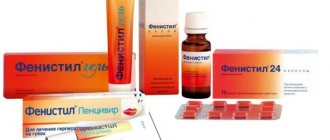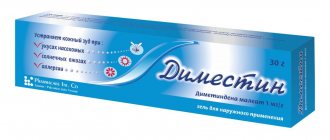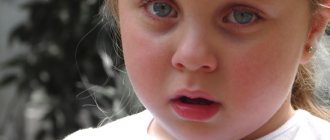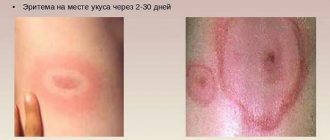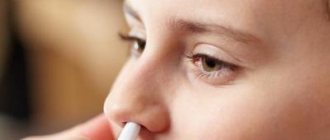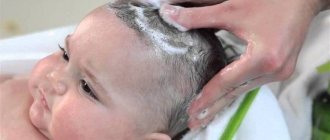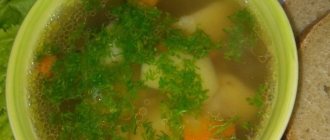Treatment of allergies in infants according to Komarovsky
Article last updated: 02/13/2019
The delicate, smooth and clean skin of a newborn baby sometimes ceases to be so. Parents notice that the baby’s skin has become dry, peeling may occur, and an incomprehensible red rash appears. The favorite localization of such symptoms is the most tender areas of the child’s body – the cheeks and butt.
In our country it is customary to call this condition diathesis. Treatment of diathesis is a very controversial issue; each doctor has his own opinion on this matter.
Diathesis - what is it?
Dr. Komarovsky, a famous Ukrainian pediatrician and TV presenter of a program about childhood diseases and conditions, does not really like to use this term. The diagnosis of “diathesis” is given to children only in our country. Doctors in other developed countries are not familiar with this concept.
If you understand the meaning of this term, it turns out that its use is really unjustified. From Greek, “diathesis” is translated as “inclination towards something.” In our case, this is a tendency to allergies. A tendency or predisposition is not a disease, it is an innate feature of the human body.
Therefore, predisposition cannot be a diagnosis and it is impossible to cure it.
In case of allergic reactions in newborns, Komarovsky recommends using the international term - allergic dermatitis.
What are allergic dermatitis?
Allergic dermatitis is an inflammation of the skin of an allergic nature. Inflammation is the body’s reaction to a foreign agent – an allergen – entering the baby’s body. An allergen can enter the body in three ways:
- With food.
- When inhaling air containing allergens.
- By contact (when the skin comes into contact with agents that cause allergies).
Allergic contact dermatitis and treatment methods
The most common type of allergy in children of the first year of life is contact dermatitis. The child was recently born and is surrounded by a large number of unfamiliar objects, many of which may pose a danger to his delicate skin.
The most common allergens are:
- Chlorine contained in tap water.
- The child's own sweat.
- Household chemicals: washing powders, fabric softeners and softeners, solid and liquid soaps, shampoos, bathing products, etc.
- Skin care cosmetics for children: creams, ointments, oils, powders, etc.
- Clothes dyes.
- Enzymes contained in feces.
Many mothers, having noticed a rash on the baby’s skin, begin to buy various creams, ointments, and bathe the baby in decoctions of medicinal herbs. All this does not bring the desired effect, because the main rule of combating allergies is not observed - identifying and eliminating the allergen.
If you stop contact of your child's skin with the allergen, no additional treatment will be needed!
Dr. Komarovsky recommends applying the following rules in caring for children under one year of age:
- After the next bath, rinse the infant with water that has been previously boiled and cooled to a comfortable temperature. This is easy to do by boiling about 2 liters of water in a kettle. When boiling, chlorine evaporates. For the same purpose, rinse children's clothes washed in the usual way in boiled water.
- Monitor the hygiene of the child’s skin, preventing the appearance of sweat. Sweat contains a large number of trace elements, including chlorine, which has an irritating effect on the skin. To do this, dress your baby according to the weather, monitor the temperature and humidity in the room.
- Choose clothes for children mostly white; bright dyes often irritate the skin.
- Feces may contain large amounts of enzymes, which can act as an allergen. In this case, you need to purchase good quality diapers that have a maximum absorption rate.
- Carefully read the ingredients of newborn baby care products and do not use them unnecessarily.
As you can see, treatment does not require the use of medications; you just need to normalize the child’s lifestyle parameters.
Food allergies in children of the first year of life: what to do?
Dr. Komarovsky has a very non-standard approach to food allergies in children of the first year of life. Komarovsky repeats several times that 100 years ago the diagnosis of “food allergy” was not known, because there was no such abundance of food, people lived from hand to mouth.
This is explained by the fact that proteins that enter the body with food must be broken down by digestive enzymes. In infants, the enzyme system is still imperfect, and the immune system is in an immature state.
When there is a lot of protein, there are not enough enzymes to break it down, and the immune system reacts to the undigested protein as a foreign substance.
One of the most common types of food allergies in children is cow protein allergy. But rarely does anyone have it for life. Children outgrow this period. This is due precisely to the maturation of the enzyme system and immunity.
Thus, Komarovsky believes that this type of allergy is associated with overfeeding the child and is not a true allergic reaction. Treatment of this condition involves maintaining optimal doses of milk and formula for a particular age.
Dr. Komarovsky recommends treating food allergies in children using unusual methods:
- In his opinion, the baby should beg his parents for food. That is, you need to give him food only at his request. Only food that is eaten with appetite is well absorbed and digested!
- Do not overfeed the baby. There are age standards that must be adhered to. Dr. Komarovsky recalls that doctors of the last century already knew that to treat skin rashes it was necessary to cleanse the intestines. To do this, it was recommended not to give water or food to children, to give an enema and to give castor oil as a laxative. In modern medicine, we have moved away from such principles of treatment, but the essence remains the same.
To summarize, it must be said that not all conditions require emergency drug treatment. In some cases, it is enough to create favorable conditions and follow a number of preventive rules that will help prevent the disease.
Treating childhood diseases is a responsible and difficult task! Don’t experiment, entrust your child’s health to professionals. Only by investing effort in the development and upbringing of a child can you get good results in the future.
Source: https://rebenokrazvit.ru/rebenok-do-goda/bolezni/lechenie-allergii-u-grudnichka-po-komarovskomu.html
Authorization
Causes of flowering in newborns
- hormonal imbalance in the baby's body. May occur due to the slow release of mother's hormones;
- increased work of the sebaceous glands;
- improper nutrition of the mother during breastfeeding.
Flowering symptoms in newborns
- acne on the baby’s cheeks and head;
- small pimples all over the body, similar to prickly heat;
- spots of red, yellow or white on the baby’s body and face.
Flowering newborn treatment
As mentioned above, only a pediatrician can prescribe treatment. The flowering of a child is a temporary, often hormonal process that may well stop without unnecessary manipulation.
It is strictly forbidden to squeeze pimples or lubricate them with greasy ointments. It is necessary to wash the baby more often, but be sure to dry the skin with a towel using soft jerky movements. The baby's skin should always remain clean and dry.
Your doctor may prescribe an ointment containing zinc to dry out pimples. You also need to be careful with it; you cannot overdry the surface of the acne. You can wipe it with chamomile a couple of times a day. Hydrogen peroxide, no more than two times a day, is treated with point movements using cotton swabs.
Skin blossoming in newborns goes away on its own by the age of three months. For many babies, it can last three to five days. This is a very individual process. But one rule applies to everyone - flowering does not bring discomfort to the baby, does not cause itching or burning. Unpleasant sensations can only arise from excessive manipulation and rubbing of the affected areas of the skin.
Acne, allergies or heat rash
What does flowering look like in newborns? Acne that appears due to flowering is somewhat different from allergic pimples. With acne, rashes can have suppuration and inflammation, which is less common in allergic reactions.
Miliaria manifests itself as a very small rash and redness in the chest, neck, armpits and groin.
But there is something common in the treatment of these three diseases - regular hygiene and dietary nutrition for mother and child.
If you notice signs of skin discoloration in your newborn baby, do not panic or become hysterical. Do not forget that the baby feels your mood and receives emotions through breast milk. And since flowering is a hormonal process, negative hormones can aggravate the disease and enlarge the affected areas.
Maintain a positive attitude, enjoy every moment spent with your child, and you won’t notice how all the pimples will disappear one by one, without leaving a trace. Frequent bathing will prevent the appearance of new pustules and will cheer up both mother and baby.
Regular consultations and examinations with a local doctor and nurse will help monitor the healing process and also prevent complications or discomfort for the baby.
Allergies in a baby: how to treat Komarovsky: advice from a famous children's doctor
Today, such a phenomenon as allergies in children (Komarovsky has his own view on this problem) occurs quite often.
Young children are especially susceptible to allergic reactions. Allergies in infants, Komarovsky believes that rarely does a baby go without reddened cheeks and spots on the skin, popularly called “diathesis,” have a complex mechanism of occurrence. An allergic reaction is a specific reaction of a child’s body to a completely ordinary irritant: medicines, food, dust, household chemicals, animal hair, etc.
By searching “Komarovsky video allergy” on the Internet, you can watch programs of a famous pediatrician, in which he talks in detail and clearly about the causes of allergies.
It doesn't take much to make it appear:
- the presence in the external environment of a component (allergen) that comes into contact with the child’s skin and reacts with sweat;
- intense sweating;
- ingestion of an allergen, the breakdown products of which are absorbed into the blood from the intestines.
BE SURE TO WATCH THIS VIDEO IN FULL.
It becomes clear how you can prevent the appearance of redness and rashes on your baby’s skin. As Dr. Komarovsky says, allergies will significantly decrease or go away completely if:
- reduce sweating;
- avoid the allergen getting inside and being absorbed into the blood;
- exclude skin contact with external irritants;
- do not limit the amount of fluid consumed;
- reduce the amount of clothing and blankets;
- maintain optimal humidity (about 60%) and comfortable (18-20 o C) air temperature.
Symptoms
Symptoms of food-type allergies in a child can be divided into two broad groups: systemic manifestations and local manifestations.
Anaphylactic shock is the systemic course of an allergic reaction, which is also the most dangerous.
Local reactions, in turn, are divided into three more large groups.
- Gastrointestinal:
- a feeling of nausea, sometimes accompanied by vomiting;
- constant regurgitation of inappropriate food;
- changes in the nature of stool: there may be either constipation or diarrhea;
- development of stomatitis;
- pain in the abdomen and the appearance of colic;
- flatulence.
This subtype of symptoms for food allergies is the most common. In some children, swelling in the lips and tongue is added to the above symptoms.
- rhinitis;
- cough reactions without objective reasons;
- infiltrates in the lung cavity;
- asthma attacks caused by broncho-obstruction.
If respiratory symptoms in response to the consumption of an allergen in food do not appear so often, then skin reactions in the form of dermatitis or rash are quite common.
Also, the severity and characteristics of symptoms vary greatly depending on how often the child comes into contact with the allergen.
If contact occurs for the first time, an acute reaction should be expected, and if the allergen enters the body constantly, then the reaction may be blurred.
Characteristic rash
What does elevated immunoglobulin E mean?
Some types of white blood cells, called mast cells or labrocytes, are coated with immunoglobulin E, which is present in both children and adults.
The main function of this substance is to help the immune system fight infectious and allergic diseases. In a healthy person, this component will be contained in minimal quantities in the blood.
The immunoglobulin indicator should be in the range of 30-240 µg/l. If a child’s global protein exceeds the norm, this may signal diseases such as:
- hay fever or hives;
- parasitic infection;
- allergic rhinitis or atopic dermatitis;
- atopic bronchial asthma or food intolerance;
- drug allergy or hyper-immunoglobulin E syndrome;
- myeloma or thymic aplasia;
- other types of allergic reactions.
Seasonal
There are three main periods when allergies to pollen appear:
- Spring period (from April to May), during the flowering period of trees;
- Summer period (June-July), when cereals are pollinated;
- Summer-autumn period (from July to September), during the dusting of weeds.
Chronic
Most often, pollen allergies have a chronic course. Manifestations of the disease gradually disappear three to four weeks after the end of exposure to the allergen. However, exacerbation of the condition may occur outside the flowering season of plants. Polinosis is promoted by the introduction of drugs into the body or the consumption of highly allergenic foods (raspberries, apricots, strawberries).
Dr. Komarovsky's advice on food allergies in children
“Using drug therapy is the last resort,” says Dr. Komarovsky about food allergies in infants and children of other age groups.
To begin with, according to this experienced pediatrician, whose advice many women listen to, it is necessary to limit the child’s consumption of a product that causes an allergic reaction.
If possible, it is recommended to completely exclude the product from the diet.
If an allergic reaction occurs in response to the consumption of not one, but several foods, then it is best, according to Dr. Komarovsky, to consult a nutritionist.
A nutritionist will help you adjust your diet so as to eliminate harmful foods and not lose any properties that these foods may provide.
Komarovsky believes that most often you should not completely remove the product from the diet, you just need to reduce its quantity.
The doctor also notes that some children outgrow their allergic reactions over time and, with age, may eat foods to which they were previously allergic.
ethnoscience
Frequent allergy attacks are fraught with negative complications. To alleviate the child’s condition, in addition to medications, the doctor may prescribe folk remedies.
The following recipes can only be used with the permission of the treating pediatrician and allergist.
Medicinal herbs
Decoctions and infusions based on them can be used internally and externally.
Among the herbs used for allergies are: nettle, chamomile, yarrow, calendula, string, horsetail, St. John's wort, licorice, calamus.
To prepare a decoction or infusion, take 2 tbsp. l. selected raw materials and 1 liter of boiling water.
It is possible to mix herbs to “enrich” the prepared product with beneficial properties.
You can use the prepared liquid for compresses and baths if there is tissue swelling, itching, or rash.
Internal decoctions and infusions are used to cleanse the blood.
This is done strictly in doses (as prescribed by the doctor, taking into account the age and physical characteristics of the child).
Complications
Occasionally, more severe manifestations of pollen allergies occur in the form of allergic forms of laryngitis, pharyngitis, tracheitis, and tracheobronchitis. Severe pollen allergies can be accompanied by bronchial asthma.
Severe attacks appear in the spring and autumn. During the rest of the year, the child does not have asthma attacks.
It happens that in some children allergies occur in the form of contact dermatitis and Quincke's edema, and urticaria occurs. The body temperature during an allergic reaction to pollen can be normal or elevated.
Treatment
You can begin to treat food-type allergic reactions only when the diagnosis has been accurately established. In this case, several basic measures are used.
- Remove from the diet all foods that cause an allergic reaction.
In this case, an allergy to three or more foods requires consultation with a nutritionist.
Food allergies are sometimes outgrown as immunological tolerance develops. Occasionally, as a test, you can give your child previously excluded foods in small portions and observe the reaction.
If the severity of the reaction allows, then the product is not completely eliminated, but its amount is reduced. If anaphylactic shock develops, be sure to completely exclude the product and not repeat its use.
- Drug therapy is used.
You should use medications only if a diet excluding allergens does not help, or if it is not possible to avoid eating allergenic foods.
The prescription of drugs must be carried out by a doctor. H2 and H1 blockers and glucocorticosteroids are mainly used. In case of systemic reactions, adrenaline is used.
- If the allergic reaction has led to severe exhaustion, then tube feeding is indicated.
- Explanatory work must be carried out with the patient, explaining to him that some products are prohibited for him.
Read how all the symptoms of hay fever manifest themselves. What does "nasal hay fever" mean? Details in the article.
List of new generation antihistamines for allergies
People who experience allergies regularly buy antihistamines and know what they are.
When taken in a timely manner, tablets can help relieve a debilitating cough, swelling, rash, itching and redness of the skin. The pharmaceutical industry has been producing such drugs for many years, and each new batch is issued as a separate generation.
Today we will talk about the latest generation of antihistamines and look at the most effective of them.
General concept of antihistamines
To everyone who wants to understand in depth the question of what antihistamines are, doctors explain that these drugs are created to counteract histamine, an allergic mediator.
When the human body comes into contact with an irritant, specific substances are produced, among which histamine exhibits increased activity. In a healthy person, it is located in mast cells and remains inactive. When exposed to an allergen, histamine enters an active phase and provokes allergy symptoms.
To relieve negative reactions, medications were invented at different times that could reduce the amount of histamine and neutralize its harmful effects on humans. Thus, antihistamines are a general definition of all drugs that have the indicated effectiveness. To date, their classification includes 4 generations.
:
Review of new generation antihistamines
Antihistamines are also called H1 receptor blockers. They are quite safe for the body, but still have some contraindications. For example, during pregnancy and childhood, a doctor has the right not to prescribe anti-allergy pills if their instructions list these conditions as contraindications.
Source: https://xn--80ahsaqcbqq.xn--p1ai/allergeny/allergiya-komarovskij-video.html
Recommendations for hypoallergenic menus
It’s good if a nutritionist creates a menu for a nursing woman. He will take into account the developmental features of the baby and mother and include the necessary products in the diet.
It is important that a hypoallergenic diet for nursing mothers includes first courses for lunch. Daily consumption of warm soups and broths improves intestinal function and increases lactation levels. Have snacks and afternoon snacks that include a fermented milk drink, natural juice or fruit.
Prepare main courses and season salads with vegetable oil. Add low-fat sour cream or a piece of butter. Spices and hot seasonings should not be used, as they will lead to digestive upset for both mother and baby. Use minimal salt and pepper when cooking. Onions and garlic can only be eaten 5-7 months after the baby is born.
If your baby’s body easily digests cookies, eat one or two cookies no more than twice a week. When breastfeeding, biscuits “Maria” and Jubilee cookies, oatmeal cookies or unleavened cookies prepared at home are suitable.
At every meal and throughout the day, drink weak black and green tea, dried fruit compotes and plain drinking water. Sometimes you can drink jelly and natural juices from an apple or pear. Do not forget to dilute the juice 1 to 1 with water in the first months. During lactation, special herbal teas for nursing mothers are useful.
Allergenic products
Today, there are about 160 known food allergens that can provoke a negative reaction in children and adults. These are mainly protein products (milk, eggs, some types of fish, etc.). Interestingly, fats and carbohydrates contained in food are not allergens in themselves, but when combined with protein they can easily cause allergies.
Products can be divided into three groups, including high, medium and low allergens. Here is a list of each group.
| Highly allergenic foods | Medium allergens | Low allergens |
| Cow's milk | Sour cream | Fermented milk products (cottage cheese, hard cheese, natural yogurt, etc.) |
| Chicken eggs | Beef and chicken | Rabbit and turkey |
| Seafood and caviar | Peas, beans and soybeans | Vegetable and butter |
| Fresh, salted and smoked fish | Pasta | Low-fat fish (pike perch, cod, hake, etc.) |
| Wheat, rye, semolina | Buckwheat, rice and oats | Barley, millet and corn grits |
| Carrots, red tomatoes, bell peppers, brightly colored vegetables | Potatoes, beets and turnips | Broccoli and cauliflower, zucchini |
| Bananas, mangoes, melons, citruses and exotic fruits | Apricots and peaches | Apples and pears |
| Strawberries and raspberries, berries of bright colors | Blueberries and black currants, lingonberries and cranberries | White currants, white and yellow cherries |
| Chocolate, cocoa and coffee | Cherries, plums and rose hips | Parsley and dill |
| Mushrooms and nuts | Bakery products | |
| Honey |
Symptoms
If a child sneezes, rubs his nose or face with his palm (itching appears), this may be a manifestation of hay fever. Due to frequent scratching of the nose, transverse folds called “allergic salute” are formed.
Allergies can also manifest themselves as:
- Skin manifestations in the form of redness and itching;
- Burning sensation on the child’s face, ears, throat;
- Nasal congestion, difficulty breathing, sneezing, mucous or watery discharge from the nose;
- Edema of the conjunctiva, photophobia, lacrimation;
- Sore throat, itching of the back of the throat, hoarseness, superficial or barking cough;
- Incessant cough, difficulty breathing, shortness of breath;
- Swelling of the face, ears, tongue, genitals.
If symptoms of pollen allergy appear in a child, you will need to consult an allergist. A doctor who will prescribe adequate treatment and preventive measures to prevent the development of bronchial asthma or Quincke's edema.
Symptoms of hay fever
Hay fever (ICD-10 code: J30.1) is an inflammatory disease of the nasal mucosa and conjunctiva, caused by a hypersensitive immune response directed against the allergen with which the child comes into contact. This means that in children with ARC, the immune system mistakenly identifies a typically harmless substance as an “invader.” In this situation, the immune system reacts to the allergen by releasing histamine and chemicals that typically cause symptoms of allergic rhinitis: itchy nose, sneezing, watery mucus and usually nasal congestion, and allergic conjunctivitis: itching/burning, red eyes.
About medicines
There is no magic pill for allergies, says Komarovsky. And every time, talking about this problem, he emphasizes that the widely advertised antihistamines that are so beloved by doctors and parents (Tavegil, Suprastin, etc.) cause dry mucous membranes. Calcium deficiency increases the manifestations of allergies, which is why in children with allergies, the disease most often worsens during teething, active bone growth, when the body consumes more calcium.
Therefore, the doctor strongly advises introducing calcium gluconate or crushed eggshells into the diet of such babies.
Local treatment with ointments and gels is quite effective and does not harm the child. True, according to Evgeniy Olegovich, they only eliminate external symptoms without affecting the cause of the problem.
Komarovsky considers corticosteroid hormones to be the best treatment option for skin manifestations of allergies.
How it manifests itself
An allergic reaction begins immediately after the antigen enters the child’s blood. This occurs within the first 2 hours after it comes into contact with the skin, mucous membranes or stomach.
All symptoms can be divided into 4 large groups:
- damage to the respiratory system. Caused by external pathogens. Characteristic: itching, sneezing attacks, nasal congestion, difficulty breathing, dry cough;
- Damage to the gastrointestinal tract occurs when the pathogen enters the body with food or medications. Manifests itself in the form of nausea, vomiting, regurgitation, diarrhea;
- Damage to the skin and mucous membranes can occur from both external and internal factors. Expressed by symptoms such as urticaria and Quincke's edema;
- The disease also affects the internal state of the child. He becomes irritable, lethargic, and there is an increase in temperature.
List of allergenic foods during breastfeeding
When breastfeeding, a mother must adhere to proper nutrition. After all, many foods often cause severe colic and food allergies in infants. In the first month of lactation, pediatricians recommend following a hypoallergenic diet, which includes only safe foods. Read more about this diet at the link https://vskormi.ru/mama/gipoallergennaya-dieta-dlya-kormyashhix-mam/.
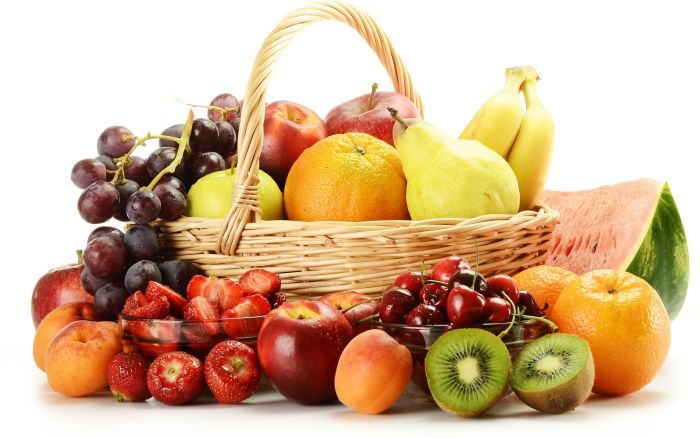
Signs of food allergies first appear in childhood. As practice shows, this disease occurs in 6-8% of children under two years of age. Moreover, up to 94% of cases develop before the age of one year! Therefore, it is important to identify an allergy or tendency to it in time, make a correct diagnosis, and begin prevention and treatment.
Side effect
The latest generation of antiallergic drugs does not have pronounced side effects. However, their manifestations should be taken into account when assessing the child’s condition and should not be burdened with homework.
The most common side effect is drowsiness. It may also be accompanied by irritability and lethargy. Sometimes there is dryness in the throat and nose. Headaches and nausea are rare.
Antihistamines
Histamine is a certain type of neurotransmitter that affects the respiratory tract, skin, gastrointestinal tract, and vascular system. Antigens enhance its effect, resulting in allergic reactions.
Preparations containing antihistamine components can reduce its activity and suppress symptoms in a child. They are also used to relieve cold symptoms.
There are 3 types of modern representatives of this group:
- H1-blockers - they are the ones used in the treatment of allergies (cetirizine, hifenadine, suprastin, loratadine, levocetirizine, sefichenadine); Photo: H1-blocker drugs
- H2 blockers - reduce gastric secretion;
- H3 blockers - used in the treatment of diseases of the nervous system.
The latest generation of drugs is practically free of side effects and has a strong effect.
Video: Treatment of allergies at the Komarovsky school
These include topical steroids. Unlike tablets, they act locally and have a small concentration of hormones. Their safety has been proven when used correctly, even in children.
The advantages of hormonal drugs are that they are highly effective and do not have a general effect on the body.
One of the disadvantages is the disabling of local immunity. If there is an infectious inflammation, hormones will only increase its spread.
For the same reason, long-term use of the drug in the same area is not recommended. This may backfire. You cannot prescribe treatment yourself; this is done only by qualified doctors.
Hormonophobia
This term refers to parents who are strongly opposed to the use of hormone-based medications. Their fear is due to incompetence in the matter and limited information.
It should be noted that the competent use of modern hormonal medications greatly facilitates the course of the disease and allows you to live a full life.
Kramony
Mast cell membrane stabilizers are available in spray form and can help relieve sneezing, watery eyes, and nasal swelling. Currently, they are not very common among allergy sufferers, but are already gaining popularity.
The advantages include the absence of side effects and versatility of use. They are applied topically to any area prone to an allergic reaction.
Medicines for a nursing mother
Since any medications that a nursing mother takes orally penetrate into the milk, they are all strictly prohibited. The solution may be topical medications, such as sprays or hormonal ointments.
Do not be afraid of the word “hormone”; modern drugs do not penetrate the body; they only have an external effect.


